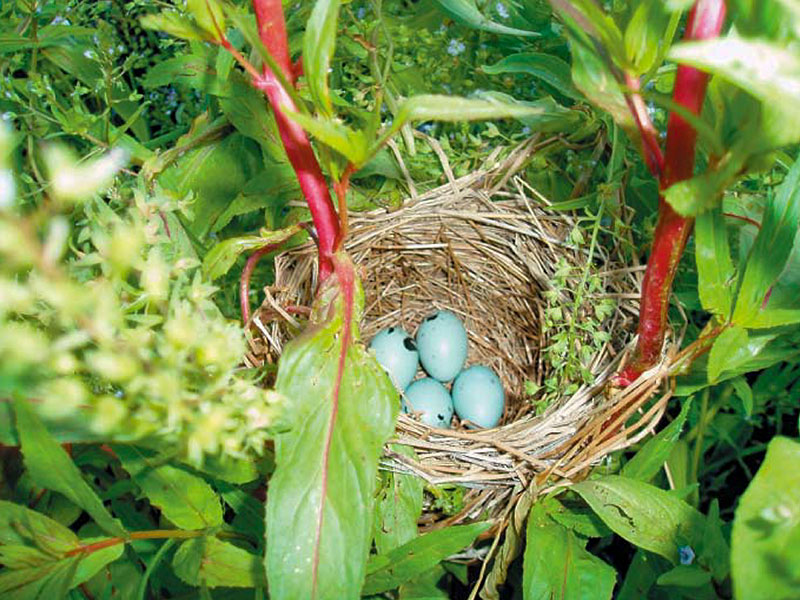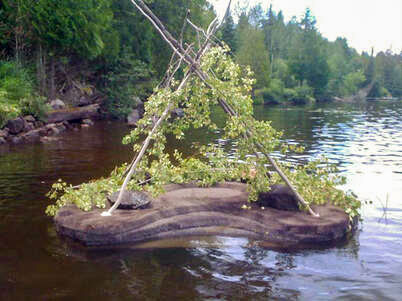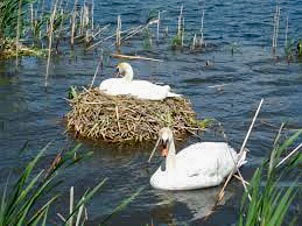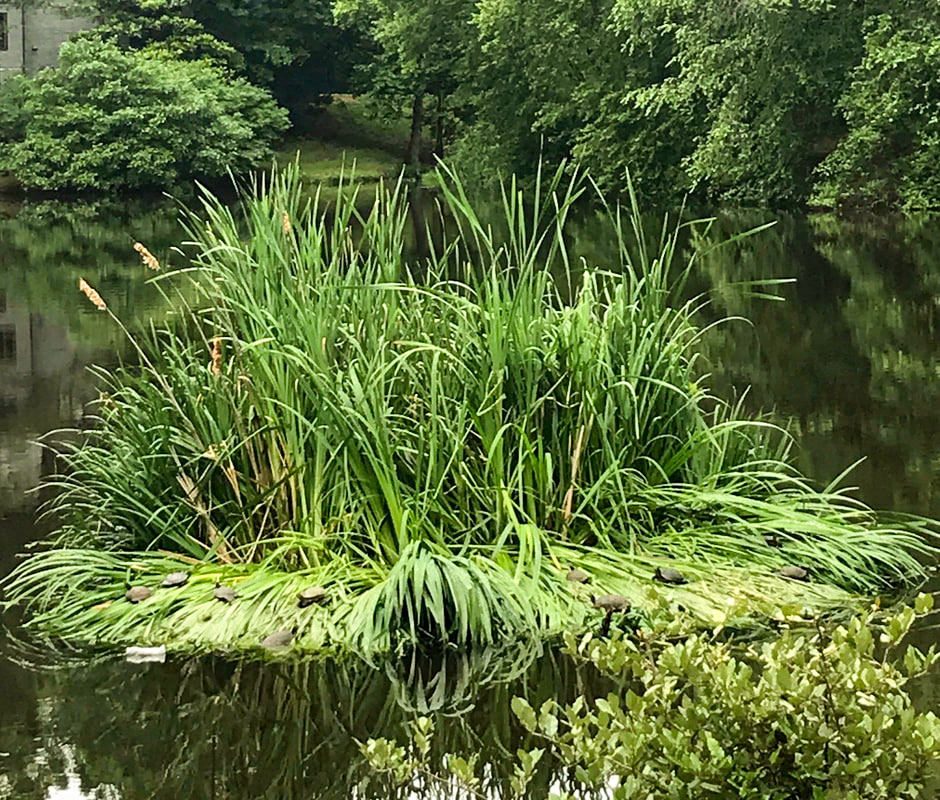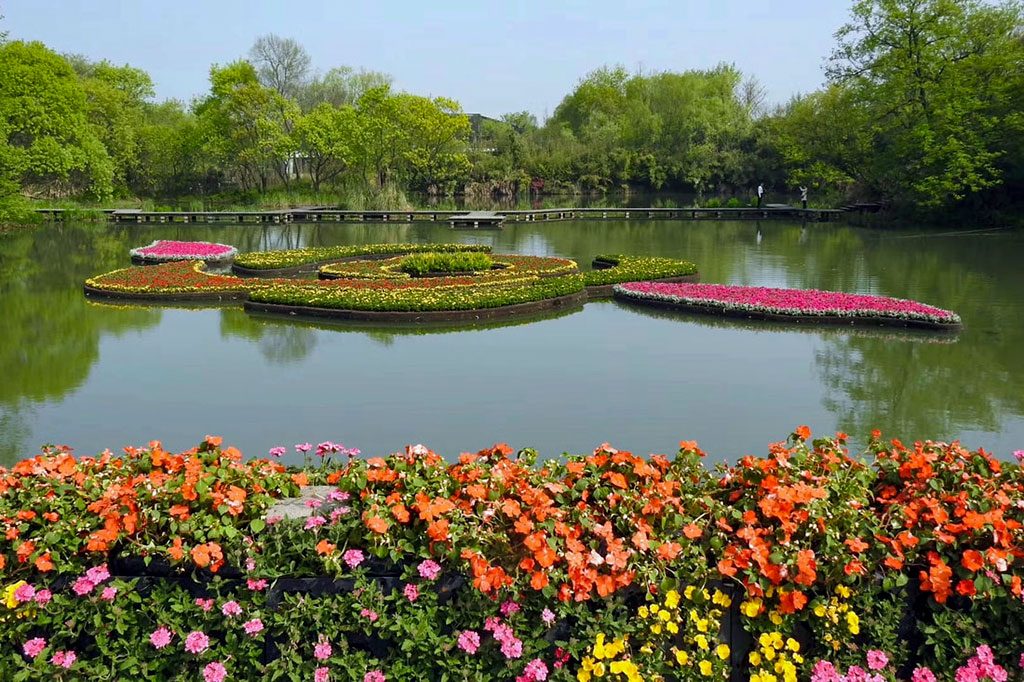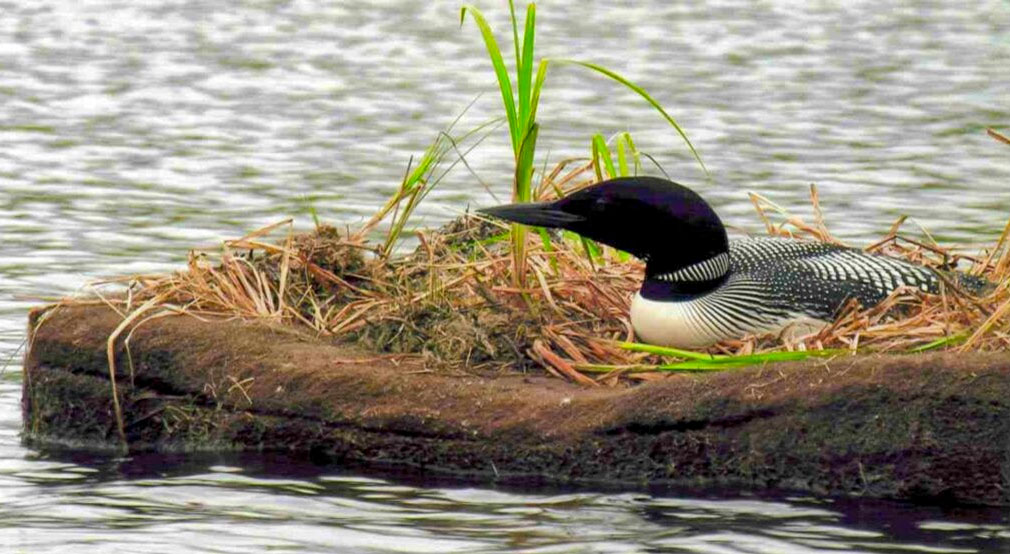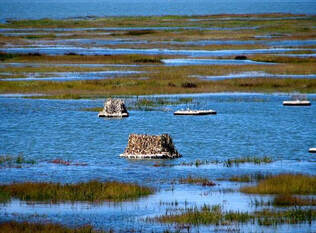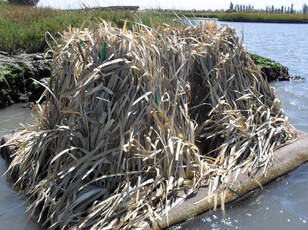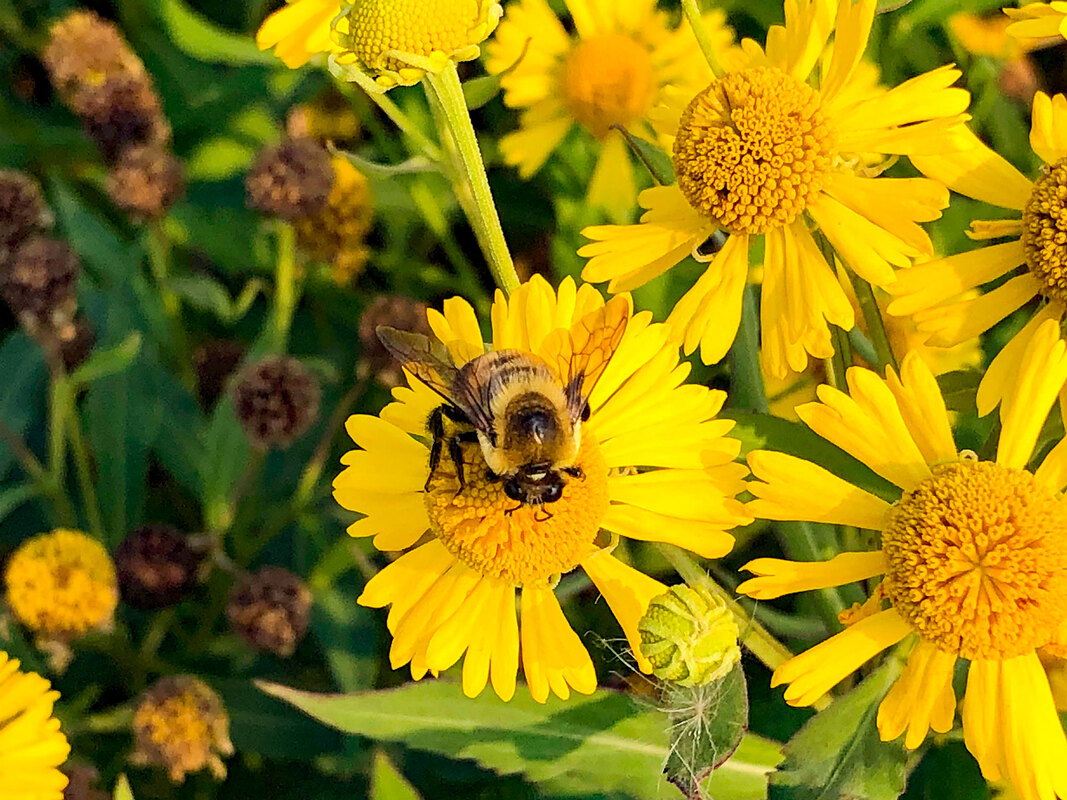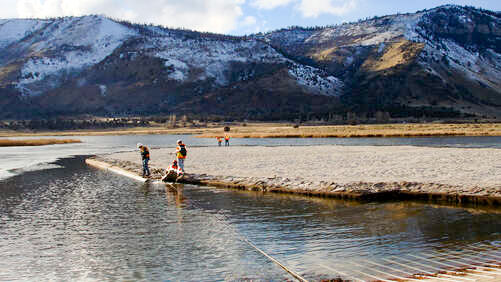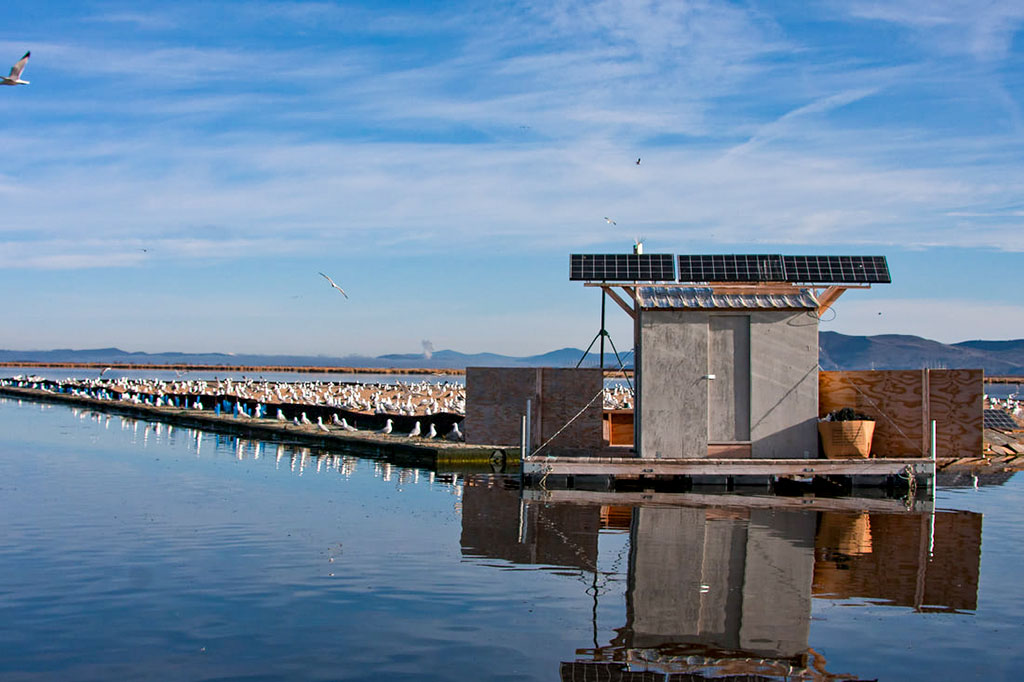BioHaven Floating Islands provide protective, riparian habitat for every layer of life - microbes, insects, birds, fish and even manatees.
BioHaven Matrix is extremely flexible and can be shaped into customized habitat that is unique to specific animals. Loon islands are made with a hollow nesting area and ramps for the chicks to get on and off. They have built-in piping for placement of overhead cover, but not too much to limit their view of oncoming danger. Turtle nesting islands may have sand boxes built in. Tern islands need to have no plant growth so are covered with gravel. The list is endless but the old saying proves true: build it and they will come. When the goal is to attract desirable wildlife, we can build an island that will provide a safe haven that protects and sustains their life model and inhibits predators.
What is habitat?
A habitat is an ecosystem* which is friendly to living things. It is a geographic location with the unique requirements to sustain certain populations in the ecosystem, supporting the food chain and perpetuation of a species. A natural habitat usually
*The term ecosystem is generally used to denote a community of all the species populations that occupy a given area and its nonliving environment (Odum 1971).
- provides protection from predators
- provides shelter from weather
- enables the food chain
- provides a source of food
- provides beneficial micro-organisms
- provides materials for nesting
- enables mating in a genetically diverse population
- is a safe landing/stopover zone for migrating animals and birds
- provides ecosystem balance
*The term ecosystem is generally used to denote a community of all the species populations that occupy a given area and its nonliving environment (Odum 1971).
Why do BioHaven Floating Islands Make Great Habitat?
Matrix is easily formed into any shape
Buoyancy can be adjusted to support extra weight
Features can be added – eg, nesting boxes, tunnels
Can support rocks, gravel, trees and plants
Multiple islands can be clustered together
Can be built in any size
Security features for birds:
Egg to chick:
nest is warm, eggs hatch earlier
less exposure to predators during incubation
a rim prevents eggs rolling off
Chick to fledgling:
young birds have immediate access to water, food
quick escape route back home
the refuge benefits young birds
Buoyancy can be adjusted to support extra weight
Features can be added – eg, nesting boxes, tunnels
Can support rocks, gravel, trees and plants
Multiple islands can be clustered together
Can be built in any size
Security features for birds:
Egg to chick:
nest is warm, eggs hatch earlier
less exposure to predators during incubation
a rim prevents eggs rolling off
Chick to fledgling:
young birds have immediate access to water, food
quick escape route back home
the refuge benefits young birds
Habitat For Birds
|
There are over 700 species of birds in North America and each of them has particular preferences and requirements when it comes to their habitats. We think of songbirds like robins, bluejays, sparrows, and raptors like eagles assembling a nest of twigs high in tree branches in which to lay their eggs. Well, the Caspian Tern prefers a big flat area at sea level with no plants. The black rail’s habitat is deep in the low grasses of a marsh.
There are a number of issues that come into play when discussing habitat for birds, including migration and breeding/nesting. |
Nesting Habitat
What constitutes a safe nesting zone for birds?
A safe nesting zone includes shelter from predators, clean water and a healthy food source as well as ready availability of nest building materials. Every species of bird has its own preferences for line of sight and materials, and requirements as to elevation of nest, proximity to water, etc.
What constitutes a safe nesting zone for birds?
A safe nesting zone includes shelter from predators, clean water and a healthy food source as well as ready availability of nest building materials. Every species of bird has its own preferences for line of sight and materials, and requirements as to elevation of nest, proximity to water, etc.
Loons
Loons are diving birds known for their sleek shape, beautiful plumage, and their haunting call. Minnesota has the largest population of common loons. They leave breeding areas in mid-autumn and migrate as far as 1,570 miles to overwinter at coastal areas. Loon nests are usually situated on a low mass of vegetation near water, often on an island. They eat fish and aquatic invertebrates.
The Biodiversity Research Institute has a dedicated loon program to track, restore, protect, and conserve four species of loon population in the US, recognizing their importance, not only to the world’s beauty, but also to its biodiversity.
The Common Loon is a key bio-indicator of aquatic integrity for lakes and near shore marine ecosystems across North America.
The call of the pacific loon:
https://www.umesc.usgs.gov/terrestrial/migratory_birds/loons/questions.html]
The Biodiversity Research Institute has a dedicated loon program to track, restore, protect, and conserve four species of loon population in the US, recognizing their importance, not only to the world’s beauty, but also to its biodiversity.
The Common Loon is a key bio-indicator of aquatic integrity for lakes and near shore marine ecosystems across North America.
The call of the pacific loon:
https://www.umesc.usgs.gov/terrestrial/migratory_birds/loons/questions.html]
How do I attract loons to my lake? What is a good habitat for loons?
|
Loons like low lying nesting areas where there is no perch for raptors and other predators don't have easy access. Having to swim to a nest is a significant deterrent. Loons like to be able to see out but be hidden as they sit on their nest. Loons like to lay eggs in a protected sloping hollow nest where they can generate warmth.
BioHaven Loon nesting islands provide a safe, durable nesting place for loons. |
They provide easy access to the water, protection from shore predators and barriers to provide overhead protection from flying predators. Improving brooding conditions is the best help we can offer for loons. Loon islands should be launched earlier in the planting season so they will be ready for when the loons are looking for a place to nest. The islands can be made with a ramp to help them easily climb onto the island. Branches can also be added for overhead protection.
BioHaven Floating Island loon nesting successes:
BioHaven Floating Island loon nesting successes:
- Washington State
- Lake Michigan
- Montana Fish and Wildlife Service
- Montana Loon Society
- Hungry Jack Lake, Minnesota
- British Columbia
Swans
|
Swans were once nearly hunted to extinction, but now they are coming back. There are two species of swan that are native to the US: Trumpeter and Tundra. The Mute Swan is the swan of fairy tales and picturesque villages but is not native to the US so is considered an exotic species.
A Trumpeter Swan can have a wingspan of up to 8 feet. Swans mate for life and when they migrate, the family unit will stay together. Swans are primarily freshwater birds who need access to shallow water. Swans need space that is undisturbed by humans and predators. They are generally territorial. Their nests are large. |
Many companies are turning to swan islands to fulfill mitigation obligations. Construction and development companies, and real estate agents involved with residential development, appreciate the benefits of supporting swan nesting habitat:
BioHaven Swan Islands are designed with these features:
BioHaven Swan Islands are designed with these features:
- Five-foot diameter elevated nest form
- Dark shade to enhance for egg incubation
- Three sloped zones along island perimeter to enhance for cygnet ingress/egress
- Extra buoyancy to accommodate their large size
Other Habitat Creation Projects
|
How do I create a habitat for turtles in my backyard pond?
Turtles must be given a safe haven from predators that lurk on the shore alongside your pond. Turtles need easy sloping access into and out of the water, a shady spot, a place to sun themselves and rest, and a plentiful food source. Turtles enjoy micro environments, and they need a place to dig under and hibernate. A floating island planted with lush native foliage and flowers is a hospitable place for turtles to build nests safe from shore-bound predators and is also attractive to insects on which the turtles feed. |
Why would I want to create a habitat for turtles in my backyard pond?
Turtles eat dead and decaying matter off of the bottom of the pond, thereby helping to reduce the production of greenhouse gas emissions. Turtles will eat slugs! They are fun to watch. Some people like to eat turtles; a turtle has about 4-5 different kinds of meat. Don’t eat an endangered one, though! But turtles can be troublesome in a pond if you plan to fish in it. Once you catch a turtle on your hook they are very difficult to release.
Turtles eat dead and decaying matter off of the bottom of the pond, thereby helping to reduce the production of greenhouse gas emissions. Turtles will eat slugs! They are fun to watch. Some people like to eat turtles; a turtle has about 4-5 different kinds of meat. Don’t eat an endangered one, though! But turtles can be troublesome in a pond if you plan to fish in it. Once you catch a turtle on your hook they are very difficult to release.
|
Hummingbird Habitat
Hummingbirds are amazing to watch, are active pollinators, and eat nuisance bugs. Renowned for their small size, amazing energetic feats, and iridescent beauty, hummingbirds are ravenous (a hummingbird’s heart beats up to 1,260 beats per minute!) and drink up to two times their body weight per day. As they move from plant to plant, they carry pollen. |
Some hummingbird species are at risk because of habitat disruption and loss. There are 300 species of hummingbirds in the world, and most of them migrate. Like all animals, they require a safe habitat with abundant food and nesting areas. They don’t need to drink water but are attracted to it. In addition to drinking nectar, hummingbirds also eat nuisance insects, like gnats and fruit flies.
How do I create a habitat for hummingbirds by my backyard pond?
A floating island planted with lush native foliage and flowers is a hospitable place for any local hummingbird populations to congregate. Hummingbirds are attracted to running water, such as a fountain, sprinkler, birdbath with a mister, or waterfall. Because they know that insect populations are higher near ponds, streams, and wetland areas, they go there for food.
Brightly-colored flowers that are tubular hold the most nectar, and are particularly attractive to hummingbirds. These include perennials such as bee balms, columbines, daylilies, and lupines; and biennials such as foxgloves and hollyhocks. It’s important to try and stick with native species of plants.
These tiny birds are attracted not just to the color red, but also purple, blue, yellow, orange, pink, and even white flowers.
We recommend you go to Pollinator.org to learn more about hummingbirds.
How do I create a habitat for hummingbirds by my backyard pond?
A floating island planted with lush native foliage and flowers is a hospitable place for any local hummingbird populations to congregate. Hummingbirds are attracted to running water, such as a fountain, sprinkler, birdbath with a mister, or waterfall. Because they know that insect populations are higher near ponds, streams, and wetland areas, they go there for food.
Brightly-colored flowers that are tubular hold the most nectar, and are particularly attractive to hummingbirds. These include perennials such as bee balms, columbines, daylilies, and lupines; and biennials such as foxgloves and hollyhocks. It’s important to try and stick with native species of plants.
These tiny birds are attracted not just to the color red, but also purple, blue, yellow, orange, pink, and even white flowers.
We recommend you go to Pollinator.org to learn more about hummingbirds.
Pollinator Habitat
BioHavens are floating pollinator arboretums. Just like the natural peat based floating islands of famed waterways like the Chippewa Flowage in northern Wisconsin, the plant diversity that occurs along an island’s riparian edge can be amazing. From insect consuming Pitcher Plants to Joe Pieweed, to Black Orchids, and hundreds of examples of unnamed wild flowers, islands have found a niche as rare plant repositories! And unlike terrestrial gardens, it’s much harder for deadly chemical treatments to upset the natural system of islands. It’s like BioHavens are islands of safety and refuge for threatened plants and birds.
How do I bring pollinators to my backyard pond?
Planting a variety of native flowering plants on a floating island will attract insects such as honey bees, bats, birds and other pollinators who transfer pollen from one flower to another flower and make them thrive. Pollinators are attracted to plants and insects on the floating island.
Three-fourths of the world’s flowering plants depend on pollinators to reproduce. Current habitat loss, disease and environmental contaminants are causing a decline in many pollinators. The islands will provide a flourishing habitat for pollinators to grow their populations but the most rewarding part may be the excited reaction when people see the dragonflies and butterflies on the island.
BioHavens are floating pollinator arboretums. Just like the natural peat based floating islands of famed waterways like the Chippewa Flowage in northern Wisconsin, the plant diversity that occurs along an island’s riparian edge can be amazing. From insect consuming Pitcher Plants to Joe Pieweed, to Black Orchids, and hundreds of examples of unnamed wild flowers, islands have found a niche as rare plant repositories! And unlike terrestrial gardens, it’s much harder for deadly chemical treatments to upset the natural system of islands. It’s like BioHavens are islands of safety and refuge for threatened plants and birds.
How do I bring pollinators to my backyard pond?
Planting a variety of native flowering plants on a floating island will attract insects such as honey bees, bats, birds and other pollinators who transfer pollen from one flower to another flower and make them thrive. Pollinators are attracted to plants and insects on the floating island.
Three-fourths of the world’s flowering plants depend on pollinators to reproduce. Current habitat loss, disease and environmental contaminants are causing a decline in many pollinators. The islands will provide a flourishing habitat for pollinators to grow their populations but the most rewarding part may be the excited reaction when people see the dragonflies and butterflies on the island.
Frogs and Toads
Why should I assure a safe habitat for frogs in my backyard pond?
Tadpoles eat algae.
A healthy frog and toad population attracts waterbirds to your yard.
Attracting frogs and toads into your garden is a pesticide-free and natural way of greatly lowering your pest population.
How do I create a habitat for frogs and toads in my garden?
Frogs and toads will come to an environment with a proper habitat. Obviously, they need water. And they need bugs. What else can you do?
Make sure the water has lots of nice oxygenating plants.
The pond should have a gradual slope, so that young frogs don’t get stuck in the water.
Providing platforms, either as small islands or with rocks, or logs can give frogs and toads somewhere to relax and breathe above the water.
Areas of vegetation, stones, and logs in and around the pond will be used by frogs as cover from predators.
Eliminate chemicals in your garden maintenance routine. You don’t want to poison them. They will take care of the bugs if you take care of them.
Why should I assure a safe habitat for frogs in my backyard pond?
Tadpoles eat algae.
A healthy frog and toad population attracts waterbirds to your yard.
Attracting frogs and toads into your garden is a pesticide-free and natural way of greatly lowering your pest population.
How do I create a habitat for frogs and toads in my garden?
Frogs and toads will come to an environment with a proper habitat. Obviously, they need water. And they need bugs. What else can you do?
Make sure the water has lots of nice oxygenating plants.
The pond should have a gradual slope, so that young frogs don’t get stuck in the water.
Providing platforms, either as small islands or with rocks, or logs can give frogs and toads somewhere to relax and breathe above the water.
Areas of vegetation, stones, and logs in and around the pond will be used by frogs as cover from predators.
Eliminate chemicals in your garden maintenance routine. You don’t want to poison them. They will take care of the bugs if you take care of them.
What is habitat loss?
Habitat loss is when the qualities of a certain area that support a population (an ecosystem) are destroyed, degraded, fragmented, or polluted. The living things that previously inhabited the area die or are displaced, which reduces biodiversity. Often this is caused by human intrusion. Natural forces can be a threat to habitat. Climate change is exacerbating habitat loss from natural forces.
In a 1995 scientific study by Noss, et. al., for the Idaho Department of Fish and Wildlife, researchers identified more than 30 critically endangered, 58 endangered, and more than 38 threatened ecosystems. If you’ve heard of “dead zones” in the ocean, or lakes, where fish kills regularly occur, then you know what the loss of habitat is.
In a 1995 scientific study by Noss, et. al., for the Idaho Department of Fish and Wildlife, researchers identified more than 30 critically endangered, 58 endangered, and more than 38 threatened ecosystems. If you’ve heard of “dead zones” in the ocean, or lakes, where fish kills regularly occur, then you know what the loss of habitat is.
What is habitat degradation?
Habitat degradation endangers the populations indigenous to the habitat by damaging it in some way. The degradation of a habitat may not be obvious. Habitat degradation includes any influence that reduces or changes the biodiversity of an area thereby threatening the health of the food chain and other parts of the ecosystem. The addition of agricultural surface runoff, excess phosphorus and nitrogen, to a small inland lake, for example, can influence the levels of dissolved oxygen, stratification, and algae growth in that lake. The careless addition of a wind farm may interrupt migratory bird patterns and fragment their habitat, as happened with the Golden Eagle along the western flyway. Habitat fragmentation interferes with migration by making it harder for migratory species to rest and find food.
Unfortunately, if you own or manage a body of water—a stormwater collection basin, a seasonal pond, a regional lake, reservoir, canal, or bay—you are probably aware of the degradation of that aquatic habitat. If you receive runoff from agriculture or landscaping, then you probably have an overabundance of phosphorus and nitrogen, two nutrients that are used in chemical fertilizers. Too much of these, and you end up with too much algae. Too much algae could result in a harmful algae bloom (HAB) and a seriously degraded habitat.
|
BioHaven Floating Islands are a natural, research-backed solution for HAB Management & Mitigation. Adding BioHaven Floating Islands adds beauty and an eye-catching feature to any body of water. They are customizable for shape, size, and buoyancy, and can be designed to create habitat for fish, amphibians, ducks and other waterfowl.
Added to a midwest private pond, our floating treatment wetland becomes a preferred home for Loons. |
Loon Nesting Islands have been enjoyed by nesting loons in Minnesota, Lake Michigan, and British Columbia, and have been used by the Montana Fish and Wildlife Service and the Minnesota Loon Society.
Added to an urban pond, a floating island fishing platform - a fish aggregation device that draws fish in - can be a central location for family outings, or an aquaculture community garden, or a park's recreational highlight. A BioHaven Floating Island can be solar powered to generate local energy or power water circulation.
Added to an urban pond, a floating island fishing platform - a fish aggregation device that draws fish in - can be a central location for family outings, or an aquaculture community garden, or a park's recreational highlight. A BioHaven Floating Island can be solar powered to generate local energy or power water circulation.
What is habitat destruction?Habitat destruction is when a habitat is no longer able to provide the food, cover, and elements of survival that a species needs to survive. Filling in wetlands for development is an example of habitat destruction. Dredging rivers is another. Habitat can also be destroyed by natural phenomena, such as when a hurricane washes over a barrier island or low-lying ground is routinely flooded.
Habitat destruction is a tremendous threat to biodiversity on land and in water environments. Floating island habitat gives this endangered bird (the California Clapper Rail) hope for survival. In Arrowhead Marsh, Oakland, California, the California clapper rail, a nearly-extinct species of bird threatened by rising sea levels and loss of coastal marshland, has been given a new hope by deploying floating islands to biomimic its natural habitat. |
|
How does habitat loss affect people?
|
Though sometimes we forget, humans depend on a healthy ecosystem for our survival. Habitat destruction is the primary cause of worldwide extinction of species. Even the loss of a single species of plant or microbe may affect our wellbeing in ways we don’t yet understand. We do understand the cost of losing a pollinator habitat, a valuable part of the ecosystem for sustaining agriculture. Without honey bees to deliver pollen, for instance, much of our food chain will be disrupted.
|
Habitat destruction increases human vulnerability to natural disasters, including pollution of drinking water, flood, drought, spread of disease, and crop failure. The reduction of protective wetlands and protective barrier islands along the Gulf Coast contributed to the loss of life and property in New Orleans after Hurricane Katrina. (See our Shoreline page to find out how BioHaven Floating Breakwaters are helping to restore it).
Loss of habitat affects rural areas and poor urban areas disproportionately.
Water, forests, and plants are responsible for cycling our air and producing oxygen, as well as for sequestering carbon dioxide and methane and counteracting the accumulation of greenhouse gases in the atmosphere. Greenhouse gas emission is the largest cause of climate change. Climate change is affecting the incidence of natural disasters, like the aforementioned Hurricane Katrina, which in turn affects low-lying urban centers.
Without invertebrates, animals, fish, and fowl, there is no healthy functioning of the ecosystem upon which we depend.
San Francisco Bay, Monterey Bay and Chesapeake Bay are all famous protected habitats yet they are also water bodies impacted by detrimental human activities. Yes, we humans value and enjoy natural habitats, but we are in danger of losing even the protected ones if we let species extinction, habitat degradation, loss and fragmentation continue at today’s rate.
Loss of habitat affects rural areas and poor urban areas disproportionately.
Water, forests, and plants are responsible for cycling our air and producing oxygen, as well as for sequestering carbon dioxide and methane and counteracting the accumulation of greenhouse gases in the atmosphere. Greenhouse gas emission is the largest cause of climate change. Climate change is affecting the incidence of natural disasters, like the aforementioned Hurricane Katrina, which in turn affects low-lying urban centers.
Without invertebrates, animals, fish, and fowl, there is no healthy functioning of the ecosystem upon which we depend.
San Francisco Bay, Monterey Bay and Chesapeake Bay are all famous protected habitats yet they are also water bodies impacted by detrimental human activities. Yes, we humans value and enjoy natural habitats, but we are in danger of losing even the protected ones if we let species extinction, habitat degradation, loss and fragmentation continue at today’s rate.
Can habitat be restored? Rescued? Rebuilt? Replaced?
Speaking of aquatic habitat specifically, yes, if we turn to nature-as-model, a strategy known as biomimicry.
Natural systems evolve around nutrients, which are indispensable to life. When they cycle, or flow, through a food web without overloading it, the ecosystem can be incredibly productive yet remain close to pristine. The challenge, however, is around the balance—the ratio—of nutrients to the food web’s ability to consume them. When it’s off, nutrients stack up and foster the growth of life forms that are not beneficial to the ecology. For example, phytoplankton is a plant, but does not need nitrogen to be present in water, as it can pull nitrogen from the atmosphere. So if there is carbon (which is almost always the case) and an imbalance of (ie, too much) phosphorus, phytoplankton (algae) is well positioned to prosper. Unfortunately, prosperous algae can often lead to Harmful Algal Blooms, polluting our pristine water.
Luckily, there is a life form that can out-compete phytoplankton, and communities of them have been doing so successfully for hundreds of millions of years. These are biofilm-generating microbes, and they are the key component of nature’s wetland system. Today humans can design for nature’s wetland system to fix water by providing critical habitat for these microbes. And you can too. We can manage water and steward it so that it is both extremely productive and healthy. This is what BioHavens specialize in…they are floating wetlands. They are versatile, and can be the path to productive and healthy water.
Natural systems evolve around nutrients, which are indispensable to life. When they cycle, or flow, through a food web without overloading it, the ecosystem can be incredibly productive yet remain close to pristine. The challenge, however, is around the balance—the ratio—of nutrients to the food web’s ability to consume them. When it’s off, nutrients stack up and foster the growth of life forms that are not beneficial to the ecology. For example, phytoplankton is a plant, but does not need nitrogen to be present in water, as it can pull nitrogen from the atmosphere. So if there is carbon (which is almost always the case) and an imbalance of (ie, too much) phosphorus, phytoplankton (algae) is well positioned to prosper. Unfortunately, prosperous algae can often lead to Harmful Algal Blooms, polluting our pristine water.
Luckily, there is a life form that can out-compete phytoplankton, and communities of them have been doing so successfully for hundreds of millions of years. These are biofilm-generating microbes, and they are the key component of nature’s wetland system. Today humans can design for nature’s wetland system to fix water by providing critical habitat for these microbes. And you can too. We can manage water and steward it so that it is both extremely productive and healthy. This is what BioHavens specialize in…they are floating wetlands. They are versatile, and can be the path to productive and healthy water.
|
|
How Do Algae Blooms Affect Birds?
Algae blooms affect many bird species in both freshwater and marine environments because of the potential for toxins to be present. These toxins are becoming increasingly recognized as a cause of waterbird death. Eutrophication of inland waterbodies used by large numbers of water birds is a result of an influx of excess nutrients, and the cause of harmful algae blooms. Most reports of mortality in birds are of die-offs that occur in conjunction with a bloom. Deaths of pelicans and cormorants have been caused by algae toxins, as well as common terns, shags, northern fulmars, herring gulls, common mures, Pacific loons, and others. Cyanobacteria is suspected in the deaths of songbirds, grebes, ducks and geese.
Elevated cyanobacteria counts (Anabaena spp.) were detected in impoundments near the die-offs and microcystins were frequently detected in water samples and in liver tissue of dead and dying great blue herons in this study.
Other toxic conditions cause bird die-offs. The chemicals in tar-sand wastewater has been known to cause die-offs (through release of naphthenic acid) and the toxic water of Berkeley Pit in Butte, Montana has experienced bird mortality in the thousands.
Elevated cyanobacteria counts (Anabaena spp.) were detected in impoundments near the die-offs and microcystins were frequently detected in water samples and in liver tissue of dead and dying great blue herons in this study.
Other toxic conditions cause bird die-offs. The chemicals in tar-sand wastewater has been known to cause die-offs (through release of naphthenic acid) and the toxic water of Berkeley Pit in Butte, Montana has experienced bird mortality in the thousands.
How can we mitigate the effects of bird habitat loss?
We can choose to mitigate the damaging effects of loss of or disruption to bird habitat in many ways from personal choices to public policy:
From Dodkins Study: “Floating Islands have sometimes been constructed specifically to create habitats e.g. to protect birds from land-based predators (Hancock, 2000), including a huge floating island of 3 700 m2 in Sheepy lake (California) as a habitat for nesting Caspian Terns (Patterson, 2012). . . . Emergent grasses attract waterfowl and terrestrial birds because of the seeds, nesting material, nesting cover and available water.”
- Conserve, preserve, protect and manage wildlife areas
- Avoid stomping through nesting areas when searching for an elusive bird
- Stay on dedicated paths and trails when walking over dunes or through wild areas
- Consider the bigger ecological impact when selecting routes for power lines, building reflective glass buildings, etc.
- Stop excessive fertilization and pesticide use, and prevent runoff to the watershed.
- Add protective barriers to shorelines and coastal areas
- Clean bodies of water using nature’s model
- Relocate bird habitats when necessary
- Rebuild bird habitats where possible
From Dodkins Study: “Floating Islands have sometimes been constructed specifically to create habitats e.g. to protect birds from land-based predators (Hancock, 2000), including a huge floating island of 3 700 m2 in Sheepy lake (California) as a habitat for nesting Caspian Terns (Patterson, 2012). . . . Emergent grasses attract waterfowl and terrestrial birds because of the seeds, nesting material, nesting cover and available water.”
What is bird relocation and why is it done?
Relocating birds is often the best solution to a complicated ecological problem. Sometimes a large bird population is decimating a population of fish in a sensitive fishery or threatening the survival of a prey species. Birds could be relocated for their own good, for instance if a bird population has outgrown its space and diseases like botulism are beginning to take hold or want to be avoided. Other times, birds might be directed towards alternative safe landing zones rather than to toxic water bodies or through impeded flyway conditions.
Another reason to relocate a bird population might be that they are a nuisance to humans, such as geese moving in to a golf-course.
Another reason to relocate a bird population might be that they are a nuisance to humans, such as geese moving in to a golf-course.
Two BioHaven Case Studies Show Bird Relocation Success
|
The large Caspian tern colony on East Sand Island at the mouth of the Columbia River consumed roughly 5-6 million young salmon and steelhead annually, limiting the success of salmon restoration efforts throughout the Columbia Basin.
Federal resource managers redistributed part of the tern colony on East Sand Island to alternative breeding sites within their historical range by constructing tern nesting habitat in Oregon and California. |
One benefit of the plan for Caspian terns would be reduced vulnerability of the tern population to potential disease outbreaks, catastrophic weather events, localized predation or disturbance events, or oil spills compared to the current state of affairs, where most terns are nesting at a single colony site.
What are the challenges posed by relocating birds?
Birds have specific habitats and are very smart about which ones they prefer.
Caspian terns prefer bare sand nesting habitat that is clear of vegetation and provides unobstructed views of potential predators. Consequently, when setting up a new habitat for them on Dutchy Lake, the U.S. Army Corps of Engineers, U.S. Geological Survey, Oregon State University, and Oregon Department of Fish and Wildlife, teamed up with Floating Island International to create a plan to attract the terns who were decimating an endangered salmon population. The floating island was covered in tree mat material to reduce weed invasion before being topped with pumice gravel.
Birds have specific habitats and are very smart about which ones they prefer.
Caspian terns prefer bare sand nesting habitat that is clear of vegetation and provides unobstructed views of potential predators. Consequently, when setting up a new habitat for them on Dutchy Lake, the U.S. Army Corps of Engineers, U.S. Geological Survey, Oregon State University, and Oregon Department of Fish and Wildlife, teamed up with Floating Island International to create a plan to attract the terns who were decimating an endangered salmon population. The floating island was covered in tree mat material to reduce weed invasion before being topped with pumice gravel.
|
Large flat rocks were placed around the perimeter of the island to provide easy means for swimming birds to get on and off the island. Then, to attract terns to nest on the floating island, over 200 Caspian tern decoys were placed on the island, along with an audio playback system that broadcasts digital recordings of Caspian tern calls.
The second Caspian Tern relocation project, to Sheepy Lake, California, was monitored closely for several years and is reported on here. |
Other FAQs on Bird Habitat
What is a bird habitat management plan?
Management plans provide explicit, strategic and adaptive sets of conservation actions required to return and maintain species to healthy and sustainable levels.
What is a colonial nesting site?
Some birds require that their nest be surrounded by other nests. These colonies of bird nests provide protection from predation. Nests may be built in shrubs and trees or on the ground, depending on the species. Nesting sites are often located on remote bird islands or on stretches of beach or riparian forests, but because many birds who nest in colonies are water birds, they are almost always near a large body of water where they can forage for food.
What is a “stopover”?
As birds migrate from one place to another, a stopover provides a location for a brief stay to eat and regain strength before continuing on to the final destination.
How do I encourage migrating birds to stopover at my pond?
Encouraging migrating birds and other wildlife to visit your pond is fairly simple, and based on doing just five things right:
Why should humans care about bird habitat?
Management plans provide explicit, strategic and adaptive sets of conservation actions required to return and maintain species to healthy and sustainable levels.
What is a colonial nesting site?
Some birds require that their nest be surrounded by other nests. These colonies of bird nests provide protection from predation. Nests may be built in shrubs and trees or on the ground, depending on the species. Nesting sites are often located on remote bird islands or on stretches of beach or riparian forests, but because many birds who nest in colonies are water birds, they are almost always near a large body of water where they can forage for food.
What is a “stopover”?
As birds migrate from one place to another, a stopover provides a location for a brief stay to eat and regain strength before continuing on to the final destination.
How do I encourage migrating birds to stopover at my pond?
Encouraging migrating birds and other wildlife to visit your pond is fairly simple, and based on doing just five things right:
- Don’t mow or use chemicals around the edge of the pond.
- Plant beneficial trees, shrubs, and other plants in and around the pond to attract insects and create shade and security.
- Create microhabitats with large rocks and ponds, sloping edges, and caves in your pond.
- Keep the water quality high, so plants will thrive, algae will be minimized, and you’ll attract beneficial insects, which in turn will attract frogs, and other beneficial wildlife that migrating birds like to eat!
- Add floating islands where birds can be safe from predators, fish, swim, find food, and nest if they’d like.
Why should humans care about bird habitat?
- Biodiversity
- Food web
- Insect control - birds eat a large number of insects
- Opportunities for photography and bird watching and study
- Opportunities for recreation/hunting
